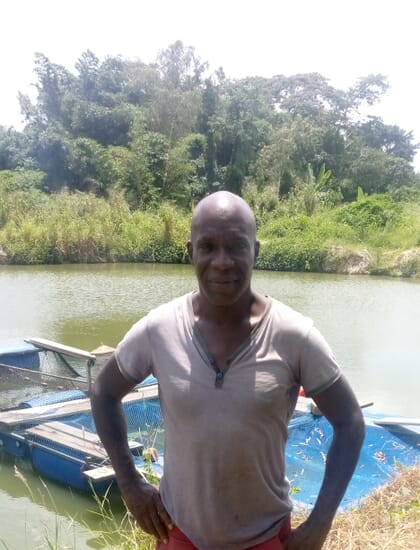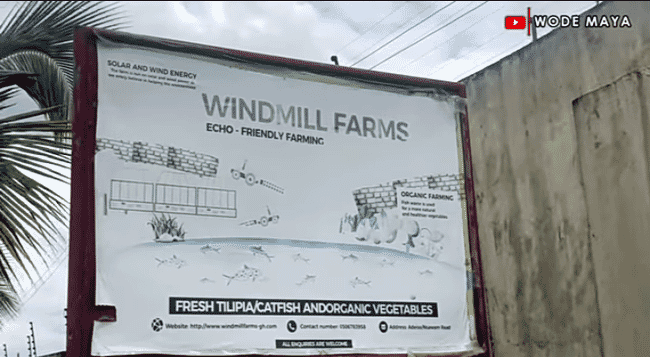
Until five years ago, Kwame Adade, born in the UK of a Ghanaian father and a Sierra Leonian mother, was a successful IT professional, working in a UK-based family business, handling banking security and telecommunications roles. But, in 2015, after a visit to Ghana, where his father had started farming catfish in square, concrete ponds, he decided that the land, the location, the water resources and even the people offered potentially big prospects in aquaculture.
As a result he moved and started Windmill Farms, which started operation the following year. His experience offers many interesting insights on the aquaculture industry – both in Ghana and in Africa in general – with many lessons for investors who are moving towards the attractive opportunities in African aquaculture, as well as for local fish farmers.

His first move was to redesign the square ponds built by his dad. Compared to the situation in European farms he visited, the job of maintaining ponds in a tropical environment is difficult and labour intensive, so he built round tanks with automated pumps which enabled him not only ensure a stable supply of water, but also to circulate the water and drain the waste down the middle, a system which has worked well.
He also decided that – due to the high cost of electricity – solar power was the best option.
“For a European type design like this one, electricity is very expensive. Solar is the best option, even though some might find the initial cost a little high. But I will choose solar any day,” Adade reflects.
Site-appropriate systems
Adade also built a dam on another parcel of family land, five kilometres from his headquarters, which was on a floodplain and offered an ample amount of water. He decided to go for a lower tech set up at this site.
“Here there’s nothing hi-tech, apart from the automatic feeding system, which saves me some labour costs,” he explains.
Adade soon found out that the concerns of Ghanaian fish farmers about high feed costs are valid, so he tested a few alternative ingredients and settled on duckweed and water lettuce, which grow abundantly on lands with high water tables, like the Adieso area where the farm is located.

"I grow both tilapia and catfish in the dam. The tilapia really enjoy these two plants, and the catfish eat the tilapia spawn, to help get the balance correct. So inside the dam I don’t use any commercial feed whatsoever. My workers collect the plants from the vicinity every week, and feed them daily, without any processing. After four weeks, we sort and transfer the biggest fish to the cages on the dams, separating tilapia from catfish, till they are about to be sold. We then transfer them to the tanks at the main site and feed them on commercial feed till they are sold, usually for a maximum of two weeks. The whole point is to save on feed expenditure. I make substantial savings on feed,” he explains.
He is in the process of tripling the size of the dam.
“Fortunately I have enough land to play with,” he reflects.
African fish farmers have always expressed concern about the high cost of fish feed, which accounts for at least 70 percent of the fish farmer’s budget. Soya meal is the main cost item, due to the fact that it is imported. Black soldier fly is seen as a good potential alternative, and some commercial production is being done in Ghana and Kenya. Adade’s interesting results are also bound to attract interest from farmers in Ghana.
Ken Essien, a catfish farmer, is seeking to speak with him about his use of aquatic plants as feeds.
“I think he’s doing something very interesting. Duckweed and water lettuce are known ingredients, even though they are not used in our part of the world. I like his idea of starting with them on the dam and transferring them to the ponds to be grown to the point of sale. There’s something that can be learnt from him,” Essien reflects.
The operation of a recirculation system also provides Kwame with the opportunity to use the fertiliser-rich wastewater for vegetable cultivation.
“That’s an interesting possibility that I am looking at. It’s certainly an attractive line that we must tap into. I’ve seen that the demand for lettuce, cabbage, carrots and a few other vegetables is quite high. This area is suitable for producing them,” says Essien.
Although traditionally tilapia is seen as an urban delicacy in West Africa, Kwame sells all his tilapia at the farm gate.
“People from the mostly rural communities around show up at the farm gate, come in and buy. I don’t do any marketing. I hope to increase output in the short term, and I’m confident that it will all be sold in the community,” he says.

However, he sells his catfish to agents from the increasing numbers of “point and kill” grill joints, who buy them at the farm gate. Currently, his monthly sales average 20 tonnes, comprising 60 percent is catfish and 40 percent tilapia.
“This is a work in progress, and I'm targeting a much higher output. I’m not shy of innovating, of changing things around in order to obtain better results. I’m confident that in the next couple of years, the farm’s output will be much higher,” he explains.
Kwame has no regrets’ about leaving a highly paid career and settling on fish farming.
“The potential here is huge. There’s no limit to how far you can grow. Currently, fish processing is becoming very attractive, especially for export. I’m not sure whether I want to simply maximise output for the expected demand boom, or to enter into processing. I am looking at the possibility of inviting investors. But presently, I’m very happy here,” he says.




